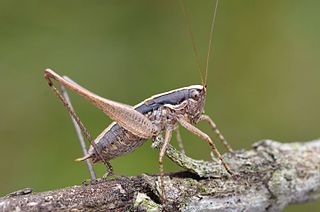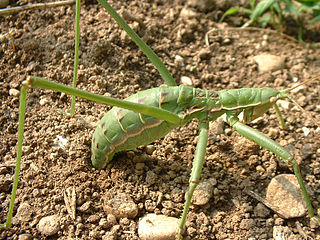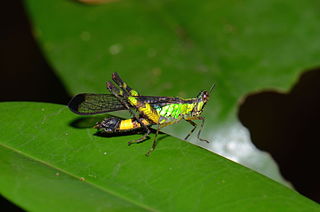
Cooloola is a genus of ensiferan orthopterans known as Cooloola monsters. It is the only genus in the subfamily Cooloolinae and family Cooloolidae of the superfamily Stenopelmatoidea.
Tetrix transsylvanica, the Transsylvanian wingless groundhopper, is a species of insect in the family Tetrigidae. It is found in Romania and Slovenia and may be extinct in Croatia.

Zaprochilus, the twig-mimicking katydids, is a genus of katydids in the subfamily Zaprochilinae. They are found in Australia. The genus Zaprochilus contains the following species:
Kansua is a small genus of katydids found in eastern Asia. Species include:

Yersinella is a genus of bush crickets in the subfamily Tettigoniinae. They are native to Europe. The genus name commemorates the entomologist who described the type species in 1860.

Saga is a genus of bush crickets or katydids containing around 15 species as of 2018. It is the only genus in the tribe Sagini.
The Tanaoceridae are a monotypic insect family in the Tanaoceroidea, which is a superfamily in the suborder Caelifera. They have been called desert long-horned grasshoppers.
Patanga is a genus of grasshoppers in the subfamily Cyrtacanthacridinae, the migratory bird locusts.

Erianthus is a genus of grasshoppers restricted to Southeast Asia. They occur in Japan, northeast India, Myanmar, Thailand, Vietnam, South China including Hong Kong, and extend east to Sumatra. In the past some neotropical species were also included in the genus. They have narrow ranges and species are identifiable only by their characteristics of male and female genitalia.
Microtettigonia is a genus of katydids endemic to Western Australia known as micro katydids. It is the only genus of the subfamily Microtettigoniinae.
Hybusa is a genus of neotropical stick-mimicking grasshoppers, the only genus in the subfamily Hybusinae. They are herbivorous.

Erucius is a genus of grasshoppers in the family Chorotypidae. Species in this genus can be found in Vietnam and Malesia, including the Philippines. It is the only genus in the subfamily Eruciinae.
Oxyphlaeobella is a genus of grasshoppers in the family Acrididae, subfamily Acridinae. Species can be found in southern China and Indo-China.
Anabropsini is a tribe of king crickets. The tribe comprises over 40 species, has a broad distribution in Old and New World tropics, including Asia, Africa, Oceania, Central America, and South America.
Cononicephora is a genus of Asian bush crickets belonging to the tribe Meconematini within the subfamily Meconematinae. They are endemic to Vietnam.
Albertisiella acanthodiformis is a species of katydid native to Indonesia. It is the only species in the genus Albertisiella.
Dictyophorus griseus is a species of African grasshopper in the family Pyrgomorphidae, the gaudy grasshoppers.
Ceresia pulchripes, the common ceresia, is a species of katydid endemic to South Africa. It is the only species in the genus Ceresia.
Luzoniella signifrons is a species of katydid endemic to the Philippines. It is the only species in the genus Luzoniella.

Poecilopsyra is a genus of katydids native to Malesia, comprising a single species, Poecilopsyra octoseriata.







